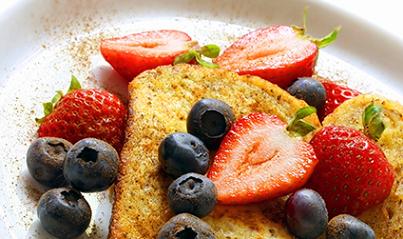
Comprehensive Weight Control Program At New York-presbyterian Hospital/Weill Cornell Medical Center
Not only will you feel more satisfied, but you’ll also burn more calories and eat less throughout the day if you load up on protein. Studies show that people who pack in protein burn about 72 more calories per day and those who eat a protein-breakfast consume 200 fewer calories a day than carb-heavy breakfast eaters. Fortunately, several classic breakfast foods are packed with the super filling nutrient – eggs, Greek yogurt, ham, Canadian bacon, and peanut butter on whole-grain bread are all great sources. Ideally, you’ll consume 30 grams of protein at breakfast.
Don’t Forget Vegetables In The Morning
It can be a challenge to eat the recommended five servings of vegetables every day. That makes working them into your morning meal essential. The perfect vessel for veggies? Eggs. Try folding chopped bell peppers, spinach, or broccoli – all high in fiber, low-carb options – into your omelet or scrambled eggs.
Pick Your Morning Meat
A common dieter’s mistake: buying turkey instead of classic pork cuts. Although is relatively lean, turkey bacon can contain up to twice as many additives as regular bacon and significantly more sodium. Besides, the difference in calories between two is negligible. Stick to a couple slices of the classic pork stuff, which is also a smarter pick than sausage. Ham and Canadian bacon are worthy choices, too.
Emphasize Eggs
Eggs may very well be the perfect breakfast food. Dieters who started their day with two eggs and toast dropped 65 percent more weight than those who ate bagel with cream cheese, a study in the International Journal of Obesity reports. Another study found that eating eggs for breakfast efficiently staves off hunger for the rest of the day. For the 143 calories in two large eggs, you net nearly 13 grams of belly-filling, hunger-fighting, muscle-building protein. Just don’t ditch the yolk. This is where most of the nutrients are housed, including brain-boosting choline; vision-preserving vitamin A, lutein, and zeaxanthin; and vitamin D and calcium. Australian scientists found that loading up on vitamin D and calcium in the a.m. can blunt your appetite.
Cut Empty Carbs
Carbohydrates from process grains elevate your insulin levels. And the more insulin circulating through your body, the more fat your body produces! Plus, these fast-burning carbs won’t keep you satisfied for long. Bagels are the primary offender, but you’ll also find the dangerous carbs in white toast, pancakes, muffins, waffles, and sugary cereals. If you’re eating a grain for breakfast, make sure it’s 100 percent whole grain or whole wheat.
Shop For The Right Cereal
If you choose the right box, you can add a hefty load of fiber to your meal. Ignore the claims on the front of the cereal box – even Cookie Crisp boasts about its whole grains – and focus on the nutrition panel on the side. Look for at least 3 grams of fiber, fewer than 200 calories per serving, and no more than 8 grams of sugar per serving. Then check the ingredients: Every grain should include the word ‘whole”, not “refined”. A few cereals that fit the bill: Post Shredded Wheat, Fiber One Honey Clusters, and Cheerios.
Practice Portion Control
Don’t just fill your bowl to the brim. Cereal serving sizes vary, so make sure to check the nutrition panel. Then use a measuring cup to dish out the appropriate amount, says Roberta Anding, RD, a dietitian and director of sports nutrition at Baylor College of Medicine. (You can even keep a measuring cup in the bow as a reminder to portion it out.) If you bowl of cereal looks measly (and unsatisfying), try pouring it into a coffee mug – you’ll trick your mind into thinking you’re eating more. Whenever you do, don’t eat cereal straight out of the bow. You’ll end up overdoing it.
Drink Water While You Wait
Is your oatmeal in the microwave? Your omelet in the pan? Grab a glass of water! Researchers from the Virginia Polytechnic Institute found that overweight people consumed fewer calories at breakfast when they drank water beforehand. Even if you’re carefully controlling your calories, water is still an easy way to boost fullness and satisfaction.
Plan You Grab-and-go-strategy
If your only breakfast option involves a drive-thru, don’t panic – you can find healthy meals if you know what to look for. Surprisingly, one of safest fast-food option comes from McDonald’s. The egg muffin contains a reasonable 300 calories, with 12 grams of fat and 18 grams of protein. If you prefer breakfast wraps, choose one that contains eggs and veggies – and doesn’t include the words “loaded,” “meaty,” or “cheesy” in its name or description.